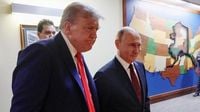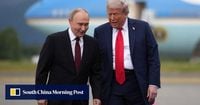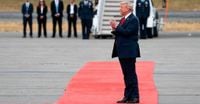As the war in Ukraine grinds on, a fresh round of diplomatic maneuvering has unfolded on the world stage, with U.S. President Donald Trump at the center of efforts to broker a peace deal between Russia and Ukraine. Despite high-profile summits, a flurry of transatlantic calls, and persistent behind-the-scenes diplomacy, the conflict shows no sign of abating. Instead, the past two weeks have been marked by both renewed military aggression and the kind of diplomatic theater that has long characterized relations between Moscow and the West.
On August 15, 2025, President Trump hosted Russian President Vladimir Putin in Anchorage, Alaska, in what was billed as a landmark summit aimed at ending Russia’s invasion of Ukraine. According to ABC News and South China Morning Post, both leaders discussed a potential path to peace, with Trump later revealing, “Every conversation I have with him is a good conversation. And then, unfortunately, a bomb is loaded up into Kyiv or someplace, and I get very angry about it.” This sense of frustration has become a recurring theme for Trump, who has repeatedly admonished Putin for Russia’s relentless nightly strikes on Ukrainian cities, even as he maintains hope for a diplomatic breakthrough.
The diplomatic overtures, however, have not yielded tangible results. In the days following the Alaska summit, hostilities only intensified. Ukraine’s air force reported that, on August 26, Russia launched 59 drones overnight, with 47 shot down or suppressed, and impacts from 12 drones recorded across nine locations. Meanwhile, Russia’s Defense Ministry claimed to have downed at least 51 Ukrainian drones, including two en route to Moscow. Both sides have escalated their use of long-range strikes, underscoring the persistent volatility of the conflict.
Despite the violence, Trump has pressed ahead with efforts to bring both sides to the negotiating table. After meeting Ukrainian President Volodymyr Zelenskyy and a host of European leaders in Washington earlier this month, Trump raised hopes for a direct meeting between Zelenskyy and Putin. Zelenskyy has signaled his willingness to attend such talks, but, as ABC News and South China Morning Post report, Putin and his officials have consistently dodged the proposal. “Maybe they will, maybe they won’t,” Trump remarked to reporters, reflecting the uncertainty that has come to define the peace process.
The diplomatic push has not been limited to presidential summits. On August 25, Secretary of State Marco Rubio spoke with European counterparts, while Trump’s Ukraine envoy, Keith Kellogg, traveled to Kyiv to meet with Zelenskyy. The focus of these discussions has been on securing future security guarantees for Ukraine—a critical sticking point in any potential settlement. Ukrainian Foreign Minister Andrii Sybiha, who participated in a call with Rubio, emphasized the need for “concrete, legally binding and effective” guarantees, spanning military, diplomatic, and legal dimensions. Zelenskyy described his meeting with Kellogg as “productive,” expressing gratitude for U.S. efforts to broker a deal. Kellogg, for his part, stated, “We are working very, very hard to get to a position where, in the near term, we have, with a lack of a better term, security guarantees. That’s a work in progress.”
Yet, the optimism expressed in diplomatic circles is tempered by skepticism—and not just among outside observers. The Los Angeles Times editorial staff, reflecting on the Alaska summit, described the event as “smoke and mirrors,” with “constructive” conversations and agreements “in principle” that lacked any concrete details. The editorial noted that Putin’s fundamental demands remain unchanged since the 2022 invasion: he seeks to redraw Ukraine’s boundaries to give Russia more territory, keep Ukraine out of NATO, and maintain military influence over Ukraine and other former Soviet regions. Putin has also demanded that Russia be included in any postwar security arrangements and be treated as an equal actor on the international stage, rather than the war criminal many Western governments accuse him of being.
Trump’s invitation to Putin to visit the United States during a period of travel bans was seen by critics as a significant public relations victory for the Russian leader. According to the Los Angeles Times, this move broke Putin’s international isolation and allowed him to present himself as a legitimate negotiating partner, while conveniently meeting in the only NATO country where he does not face war crimes charges. The timing of increased Russian military aggression in eastern Ukraine—before, during, and after the summit—has only fueled suspicions that Putin is using the talks to strengthen his negotiating position by grabbing as much territory as possible.
Throughout this period, Trump has also sought to address broader security concerns. On August 25, he revealed that he had discussed limiting nuclear weapons with Putin and plans to involve China in future denuclearization talks. “We are talking about limiting nuclear weapons,” Trump said, warning that China could match U.S. and Russian nuclear capabilities within five years. He stressed that nuclear proliferation must stop, viewing Putin’s Alaska visit as a sign of willingness for negotiations despite ongoing attacks in Ukraine, as reported by Economic Times.
Still, the lack of concrete progress has drawn criticism from multiple quarters. Some see the summit as part of a broader strategy, with Trump positioning the conflict as “Biden’s war” rather than Putin’s aggression, potentially creating space for future diplomatic solutions by reducing blame on Russia. Others argue that the diplomatic engagement may have prevented more harmful outcomes, noting that immediate territorial concessions to Russia did not materialize at the summit. European leaders have expressed relief on this front, even as they remain wary of Russia’s intentions.
The prospect of a peace deal remains elusive. After a call with Putin on August 18, Trump initially claimed that the Russian leader had agreed to a bilateral meeting with Zelenskyy. However, Moscow quickly backtracked, stating that no such talks were planned. As of August 26, 2025, there is still no agreement on the table, and the war continues unabated. In the words of the Los Angeles Times editorial, “the comments signify nothing—or, worse, make us wonder what Trump has given away to Putin with his talk of land swaps.”
For now, the world watches as diplomatic theater and battlefield realities collide. The stakes could not be higher, and while talk of peace persists, the road ahead remains fraught with uncertainty and peril for Ukraine and the wider region.


